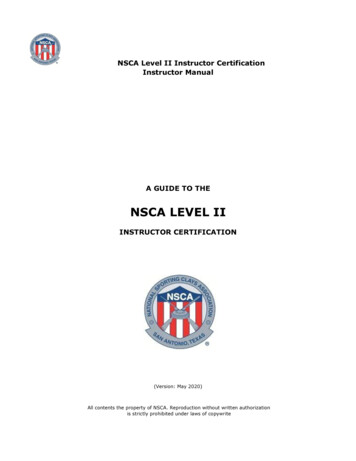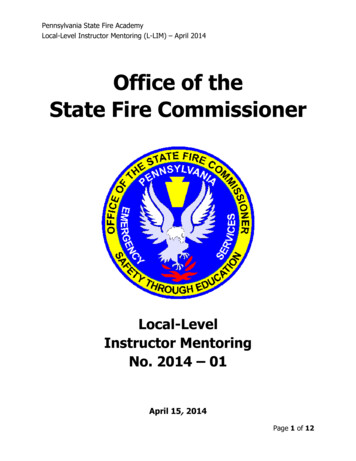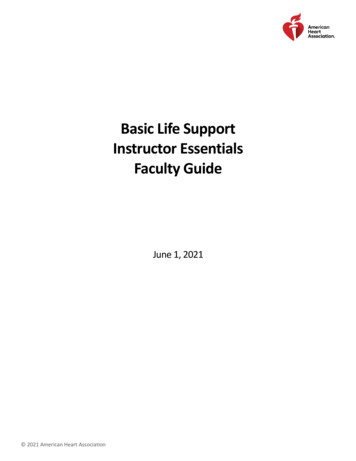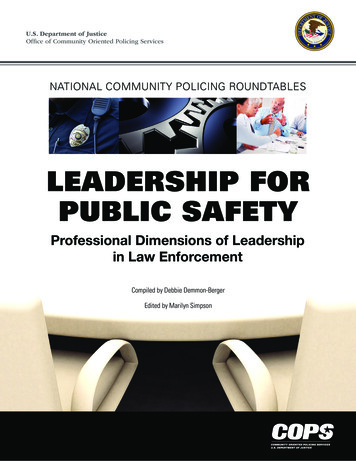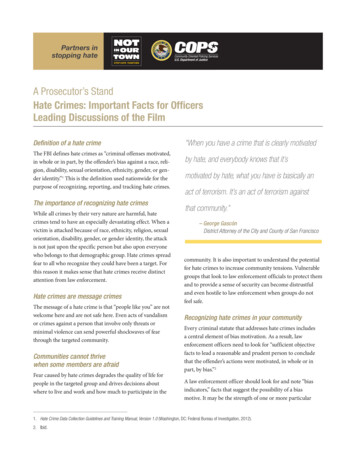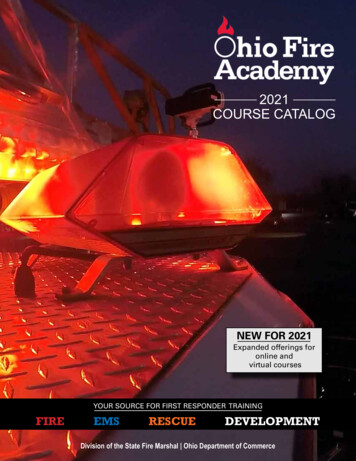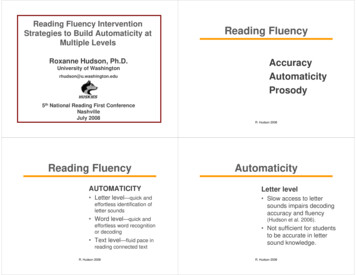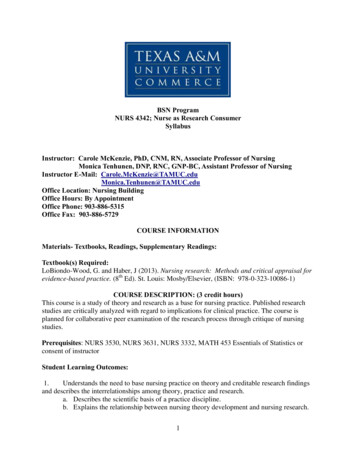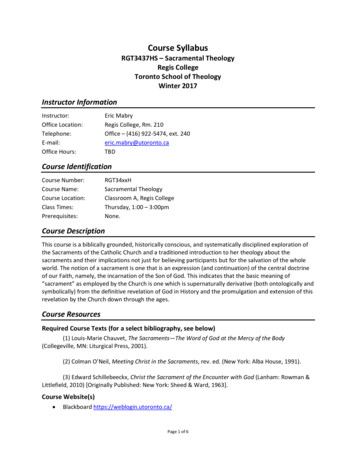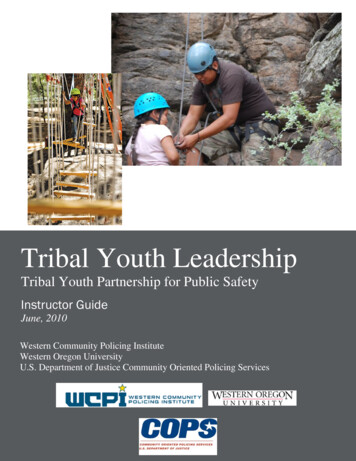
Transcription
Tribal Youth LeadershipTribal Youth Partnership for Public SafetyInstructor GuideJune, 2010Western Community Policing InstituteWestern Oregon UniversityU.S. Department of Justice Community Oriented Policing Services
Tribal Youth LeadershipTribal Youth Partnership for Public SafetyInstructor GuideTable of ContentsAcknowledgements . 7Tribal Youth Partnership for Public Safety. 8Cognitive Course Goal. 8Course Development. 9Target Audience. 9Scope of Course . 9Course Objectives . 11Course Schedule. 11Instructor Preparation. 17Introduction to the Instructor Guide . 20Session 1 – Administrative Page . 24Duration . 24Scope Statement. 24Terminal Learning Objectives (TLO). 24Enabling Learning Objectives (ELO) . 24Resources . 24Instructor to Participant Ratio. 24Assessment Strategy . 25Instructor’s Note: . 25Session 1 – Introductions and Logistics . 26Welcome . 26Housekeeping. 26Ground Rules . 26Program Overview . 27Session 1 Overview. 28Session 1 Wrap-Up . 31Session 2 – Administration Page. 32Duration . 32Scope Statement. 32Terminal Learning Objectives (TLO). 32Enabling Learning Objectives (ELO) . 32Resources . 32Instructor to Participant Ratio. 32Assessment Strategy . 32Session 2 – Define Identified Public Safety Problem . 33Session 2 Overview. 33Session 2 Wrap-Up . 36Session 3 – Administration Page. 37Duration . 37Scope Statement. 37Terminal Learning Objectives (TLO). 37Page i
Tribal Youth LeadershipTribal Youth Partnership for Public SafetyInstructor GuideEnabling Learning Objectives (ELO) . 37Resources . 37Instructor to Participant Ratio. 37Assessment Strategy . 37Session 3 – What about my values?. 38Session 3 Overview. 38Leadership and your values . 38Session 3 Wrap-Up . 42Session 4 – Administration Page. 43Duration . 43Scope Statement. 43Terminal Learning Objectives (TLO). 43Enabling Learning Objectives (ELO) . 43Resources . 43Instructor to Participant Ratio. 43Assessment Strategy . 43Session 4 – What does it take to be a leader? . 44Session 4 Overview. 44Personal Story . 45Personal Leadership . 46Session 4 Wrap-Up . 50Session 5 – Administration Page. 51Duration . 51Scope Statement. 51Terminal Learning Objectives (TLO). 51Enabling Learning Objectives (ELO) . 51Resources . 51Instructor to Participant Ratio. 51Assessment Strategy . 51Session 5 – How can I solve problems? . 52Session 5 Overview. 52Personal Story . 56Critical Thinking. 57Emotional Intelligence . 58Session 5 Wrap-Up . 62Session 6 – Administration Page. 63Duration . 63Scope Statement. 63Terminal Learning Objectives (TLO). 63Enabling Learning Objectives (ELO) . 63Resources . 63Instructor to Participant Ratio. 63Assessment Strategy . 63Session 6 – How can I set goals? . 64Page ii
Tribal Youth LeadershipTribal Youth Partnership for Public SafetyInstructor GuideSession 6 Overview. 64Personal Mission, Vision, and Values Statements. 66Decision Making and Goal Setting . 68SMART Goal Setting. 69Session 6 Wrap-Up . 70Session 7 – Administration Page. 71Duration . 71Scope Statement. 71Terminal Learning Objectives (TLO). 71Enabling Learning Objectives (ELO) . 71Resources . 71Instructor to Participant Ratio. 71Assessment Strategy . 71Session 7 – How can I resolve conflicts? . 72Session 7 Overview. 72Leadership and Conflict Resolution. 78Session 7 Wrap-Up . 80Session 8 – Administration Page. 81Duration . 81Scope Statement. 81Terminal Learning Objectives (TLO). 81Enabling Learning Objectives (ELO) . 81Resources . 81Instructor to Participant Ratio. 81Assessment Strategy . 81Session 8 – How can I work in my community?. 82Session 8 Overview. 82Guides to good listening . 83Group Development. 84Session 8 Wrap-Up . 88Session 9 – Administration Page. 89Duration . 89Scope Statement. 89Terminal Learning Objectives (TLO). 89Enabling Learning Objectives (ELO) . 89Resources . 89Instructor to Participant Ratio. 89Assessment Strategy . 90Instructor’s Note: . 90Session 9 – How can I present my ideas?. 91Session 9 Overview. 91Session 9 Wrap-Up . 98Session 10 – Administration Page. 99Duration . 99Page iii
Tribal Youth LeadershipTribal Youth Partnership for Public SafetyInstructor GuideScope Statement. 99Terminal Learning Objectives (TLO). 99Enabling Learning Objectives (ELO) . 99Resources . 99Instructor to Participant Ratio. 99Assessment Strategy . 100Instructor’s Note: . 100Session 10 – How I will develop a program . 101Session 10 Overview. 101Session 10 Wrap-Up . 105Session 11 – Administration Page. 106Duration . 106Scope Statement. 106Terminal Learning Objectives (TLO). 106Enabling Learning Objectives (ELO) . 106Resources . 106Instructor to Participant Ratio. 106Assessment Strategy . 106Session 11 – How I will market a program. 107Session 11 Overview. 107Session 11 Wrap-Up . 110Session 12 – Administration Page. 111Duration . 111Scope Statement. 111Terminal Learning Objectives (TLO). 111Enabling Learning Objectives (ELO) . 111Resources . 111Instructor to Participant Ratio. 111Assessment Strategy . 111Session 12 – How I will lead a program . 112Session 12 Overview. 112Session 12 Wrap-Up . 112Appendix A - Writer’s Checklist . 113Using visuals in a presentation . 113Delivering a Presentation. 113Delivery Techniques that Work . 114Nonverbal Message Techniques . 114Presentation Checklist. 114Appendix B - Problem Solving Workbook Response Example . 115Problem Solving Worksheets – (Student’s Copy) . 115STEP ONE – Program Learning Issues . 115Scanning. 117Analysis. 118Responses. 119Page iv
Tribal Youth LeadershipTribal Youth Partnership for Public SafetyInstructor GuideAction Plan. 119STEP TWO – Program Planning . 120STEP THREE – Program Presentation. 122STEP FOUR – Program Development . 123STEP THREE – Program Development . 124STEP FIVE – Conference Presentation . 127STEP SIX - Assessment. 128STEP SEVEN - Maintenance . 129Appendix C – Poster Campaign . 130References. 137Version 1 – June, 2010Page v
Tribal Youth LeadershipTribal Youth Partnership for Public SafetyInstructor GuideTribal Youth LeadershipTribal Youth Partnership for Public SafetyThis project was supported by Cooperative Agreement Number 2009HEWXK001 awarded bythe Office of Community Oriented Policing Services, U.S. Department of Justice. Theopinions contained herein are those of the author(s) and do not necessarily represent theofficial position or policies of the U.S. Department of Justice. References to specific agencies,companies, products, or services should not be considered an endorsement by the author(s) orthe U.S. Department of Justice. Rather, the references are illustrations to supplementdiscussion of the issues.Western Community Policing InstituteWestern Oregon University345 N. Monmouth AvenueMonmouth, Oregon 97361Visit us at: www.westernrcpi.com and www.tribaltraining.comTribal Youth Leadership – Tribal Youth Partnership for Public Safety ProgramPage 6
Tribal Youth LeadershipTribal Youth Partnership for Public SafetyInstructor GuideAcknowledgementsWestern Oregon University - Western Community Policing Institute, extend sincerethanks to the Marion County Sheriff’s Office, and the Chemawa Indian School, studentsof Chemawa, who provided insight, skill, ability, and dedication to making theircommunities safer.Western Oregon University – Western Community Policing InstituteBrian Kauffman, Executive DirectorRobert De Poe, Program ManagerMichelle Kobold, Program SupportPage 7
Tribal Youth LeadershipTribal Youth Partnership for Public SafetyInstructor GuideTribal Youth Partnership for Public SafetyCognitive Course GoalThis course is designed to train and equip American Indian youth with theleadership skills necessary to address the public safety problems that plaguestribal communities.The overarching goal for this course is to advance the practice of community policing asan effective strategy in a communities’ efforts to improve public safety. This courseencourages and facilitates the development of the leadership skills of tribal youth byencouraging partnerships and enhancing trust with law enforcement. This program willalso provide students with the leadership skills necessary in facilitating positive changein their lives and in their communities. Students will be given the opportunity to practicethese skills in a safe student-centered learning team environment.One unique aspect of this course is that leadership, problem-solving, partnershipbuilding, communication, and tribal core competencies will allow tribal youth to act asleaders, and as change agents to address public safety problems in their communitiesand in the nation.Public safety problems that plague tribal communities require the best efforts andcollaboration of the whole community, including the public and private sector. Thiscourse offers tribal youth “hands-on” application and insight into the tribal community’sroles and responsibilities in managing the public safety problems.This proposed training program will: advance community policing, problem solving, and community engagement in IndianCountry communities awarded under the 2009 TRGPimprove the implementation of community policing principles throughout tribalgovernment systemsimprove the utilization of training expertise to address local needsincrease the level of empowerment in tribal government and law enforcement agenciespromote the development/leadership capacity of tribal youth to encourage theirparticipation in developing solutions to public safety problemsPage 8
Tribal Youth LeadershipTribal Youth Partnership for Public SafetyInstructor GuideCourse DevelopmentThis course was developed by Western Oregon University - Western CommunityPolicing Institute (WCPI), in collaborative partnership with Chemawa Indian School staffand students, Marion County Sheriff’s Office, and American Indian leaders and subjectmatter-experts from across the country.This course has been designed to both provide leadership skills and to garner theyouth’s perspective in addressing public safety problems by using effective and efficientculturally-supportive philosophies. To accomplish this, course content has beendeveloped to provide leadership skills training and to provide students with anopportunity to apply their leadership skills by addressing a public safety problem foundwithin their community.This course is modified from a program developed at Chemawa Indian School. AtChemawa, over the course of one school year, project staff and American Indiansubject matter experts presented Tribal youth leadership information to a group ofChemawa Indian School students that volunteered to be part of this project. Studentsapplied these skills as they worked with project staff to develop the Freedom From Meth(FFM) American Indian youth-focused meth prevention course.Target AudienceThis course is designed for American Indian middle school and high school
Tribal Youth Leadership . Tribal Youth Partnership for Public Safety . Instructor Guide . June, 2010 . Western Community Policing Institute . Western Oregon University . U.S. Department of Justice Community Oriented Policing Services . Tribal Youth Leadership
